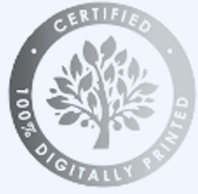THE ENVIRONMENTAL BENEFITS
OF DIGITAL PRINTING
It is extremely important that we as direct mail marketers look for ways to reduce our environmental impacts. This means that we must find the best possible ways to produce high-quality, successful mail campaigns while also reducing waste, getting the most out of our materials and lowering our energy consumption.
Digital printing has been proven to be a much more eco-friendly process than traditional lithographic and offset processes. Here are some of the top environmental benefits of digital printing:
1. DIGITAL PRINTING IS MORE EFFICIENT THAN OFFSET PRINTING. Digital printing requires less paper and less ink than offset printing.
A recent study found that, for a small print run, offset printing used 3.7 times more paper than digital printing for the same job. That same study found that offset printing used about 16g/impression of ink, while digital printing only used 1g/impression.
2. DIGITAL PRINTING PRODUCES SIGNIFICANTLY LESS PAPER WASTE THAN OFFSET PRINTING. Offset printing methods consistently produce about 15% paper waste. This amount can be even higher for smaller print runs. Digital printing reduces paper waste by about 10% or more. This means that digital printing has a 95% usable rate, making it far better for the environment and far more efficient as a production process.
3. DIGITAL PRINTING VIRTUALLY ELIMINATES INK WASTE. Ink waste is a major consideration in lithographic processes, particularly on smaller print runs. A study found that about 0.5g/impression of ink is wasted on large lithographic print runs, with that number rising to 2.7g/impression for smaller runs. Digital ink waste is minimal. This is even more significant when you consider that most unused ink is recycled in digital printing.
4. DIGITAL PRINTING USES LESS ENERGY THAN OFFSET PRINTING. According to Big Picture, “Historically, solvent-based printing machines tended to be less energy efficient because of the heat required in the drying part of the process. In addition, venting and ducting were both essential requirements for extracting solvents away from the print floor.” Modern digital printing brings “energy-saving and eco-driving principles into its design, build and ultimate operation.” This means that digital printing requires far less energy, end-to-end, making its environmental footprint much smaller than lithographic processes.
5. DIGITAL PRINTING DOES NOT USE TOXIC CHEMICALS. Conventional printing requires a lot of chemicals, from those used in the inks themselves to the chemical solvents needed for cleaning and maintenance. Digital printing uses water-based, soluble ink, eliminating chemicals that are both toxic and damaging to the environment.
6. DIGITAL PRINTING DOES NOT EMIT CANCER-CAUSING VOCS. Traditional printing emissions frequently include Volatile Organic Compounds (VOCs). The American Lung Association states that “breathing VOCs can irritate the eyes, nose and throat, can cause difficulty breathing and nausea, and can damage the central nervous system as well as other organs. Some VOCs can cause cancer.” Because digital printing uses water-based inks, the Environmental Protection Agency (EPA) explains that it does “not produce emissions” and therefore does not produce VOCs.
7. DIGITAL PRINTING IS ON DEMAND — SO YOU DON'T HAVE WASTED INVENTORY. Because digital printing is fast and flexible, you don’t have to worry about pre-printing excess inventory. This means that you won’t ever have to throw out hundreds of thousands of unusable mail pieces. Not only does this help the environment, but it also helps your bottom line.
Wilen Group remains committed to finding and utilizing the latest environmentally friendly production methods. To discuss your options and how we can help you reduce the environmental footprint of your direct mail, contact us today.
Sources:
https://www.eartheclipse.com/environment/environmental-benefits-digital-printing.html
https://scholarworks.rit.edu/cgi/viewcontent.cgi?referer=https://www.google.com/&httpsredir=1&article=1027&context=books
https://www.epa.gov/air-emissions-monitoring-knowledge-base/monitoring-information-industry-printing-and-publishing
https://www.lung.org/clean-air/at-home/indoor-air-pollutants/volatile-organic-compounds



